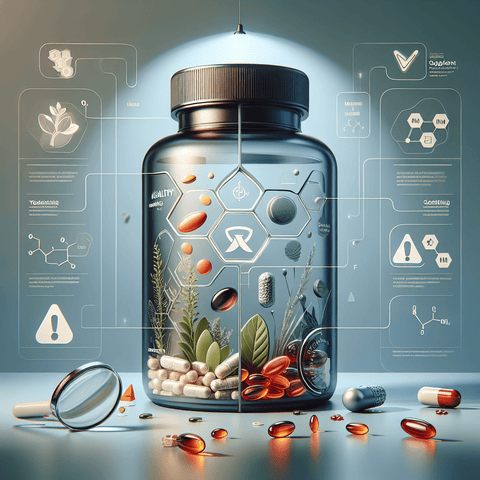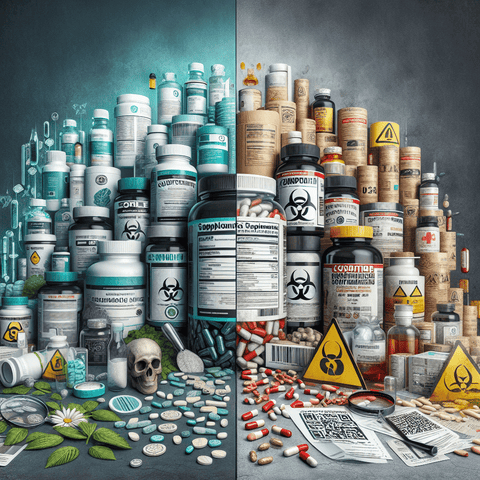Introduction
Over the last few decades, the dietary supplement market has exploded into a multibillion-euro global industry. With promises of boosting immunity, improving energy, enhancing cognition, and supporting general wellness, supplements have become part of daily health regimens for millions. From vitamins and minerals to herbal extracts, amino acids, and specialty blends, choices abound. But with so many options available, consumers face a pressing and often overlooked issue: how can you be sure that the supplement you’re taking is safe and free from harmful additives?
While many products on the market offer sound benefits when used correctly, there are serious risks associated with supplements that are poorly formulated, misbranded, or contaminated. Not all supplements are created equal, and some may include unnecessary fillers, dangerous additives, or undisclosed ingredients that can do more harm than good—especially for individuals with sensitivities or chronic health conditions.
This blog post will equip you with the knowledge and tools needed to become a savvy supplement user. We’ll explore what supplement safety really means, how to identify and avoid harmful ingredients, and which certifications and labeling practices you can trust. Ultimately, understanding how to scrutinize what goes into your body will empower you to make informed, safe decisions about your supplement regimen. Whether you're just beginning your health journey or are looking to optimize your current routine, knowing how to evaluate supplement safety is essential for protecting your health and well-being in the long term.
Supplement Safety: Why It Matters in Nutritional Supplements
Supplement safety is not just a buzzword—it's a pivotal aspect of health management. At its core, supplement safety refers to ensuring that a dietary product is free from harmful contaminants, contains only the ingredients listed on its label, and is produced under quality-controlled conditions. This topic is critically important because unlike pharmaceutical drugs, most dietary supplements are not subject to premarket approval for safety or efficacy by regulatory bodies like the U.S. Food and Drug Administration (FDA).
The Dietary Supplement Health and Education Act (DSHEA) of 1994, which defines how supplements are regulated in the U.S., treats these products more like food than drugs. While European regulations provide more oversight—especially under the EFSA (European Food Safety Authority)—gaps still exist in ensuring the consistent safety and purity of all imported and over-the-counter supplements.
One major misconception is that supplements labeled as “natural” or “plant-based” are inherently safe. However, the term “natural” is not strictly defined and can be used liberally. Certain natural compounds may still cause adverse reactions or interact negatively with medications. For instance, aristolochic acid—a naturally occurring compound found in some traditional herbal remedies—has been linked to kidney damage and cancer.
Consumers have reason to be cautious. There have been numerous examples of supplement recalls and safety alerts across countries. Products like certain weight-loss supplements containing undeclared pharmaceutical compounds or sports enhancers tainted with steroids have been pulled from shelves. These incidents highlight the risks of mislabeling, contamination, or deliberate adulteration of supplements.
To help safeguard yourself at a glance, consider this preliminary checklist:
- Check if the product label includes clear, full ingredient disclosure.
- Look for third-party testing certifications (more on this later).
- Research the manufacturer and read verified reviews when available.
- Ensure the product is aligned with EFSA health claim regulations.
- Avoid products with vague terms like “proprietary blend” without details.
By understanding and applying these principles, you'll reduce your risk of consuming supplements that can compromise your health instead of supporting it.
Dietary Supplement Risks: Know What You're Putting Into Your Body
While supplements can enhance wellness when used appropriately, they may also pose several risks—especially when selected without proper scrutiny. These risks include chemical contamination, inaccurate dosing, harmful interactions with medications, and reliance on unsubstantiated health claims. Supplements are not risk-free, and the margin for error can be significant when choosing low-quality products or misusing even the most benign-seeming multivitamin.
One of the major risks in the supplement industry is contamination. Whether stemming from incomplete purification processes, poor quality control, or deliberate spiking with pharmaceutical substances, contamination can lead to serious health issues. For example, heavy metals like lead, arsenic, and mercury have been detected in various herbal and mineral supplements, which emphasizes the importance of purchasing products from reputable sources that undergo regular testing.
Another concern is inaccurate dosing. Consuming too much of a given ingredient—such as fat-soluble vitamins like A, D, or K—can lead to toxicity over time. Products may contain more (or less) of an ingredient than what is listed on the label, especially if not third-party verified.
Interactions are also a critical factor. Supplements can significantly interact with medications. For instance, St. John’s Wort, often used for mood support, can interfere with the effectiveness of antidepressants, oral contraceptives, and blood thinners. Calcium supplements can inhibit the absorption of certain antibiotics. The implications for your health can be grave if these interactions are not adequately managed.
Specific populations must be even more cautious. Pregnant women, children, and the elderly have unique physiological needs and limitations. Pregnant women, for example, must avoid high intake of vitamin A due to its teratogenic potential. Children should not consume adult-formulated supplements unless approved by a healthcare provider. Athletes may unknowingly consume banned substances if relying on untested performance enhancers.
Lastly, beware of so-called proprietary blends. These blends may list multiple ingredients under a single combined weight, making it impossible to determine the dose of each component. While designed to protect brand secrets, they are often a way to disguise low dosages of expensive ingredients or hide potentially harmful substances.
In case of doubt, consulting a healthcare provider or pharmacist before starting any new supplement is always wise. It can protect you from unforeseen health consequences and help you choose a product tailored to your physiological and chemical needs.
Identifying Harmful Additives: What to Watch Out for on the Label
One of the most revealing components of any supplement is its ingredient label. The primary active ingredients may be front and center, but it’s the “inactive” elements—fillers, binders, colorants, and preservatives—that often tell you whether the product prioritizes health or cost-cutting. Understanding how to detect harmful additives is essential for any health-conscious consumer.
Some common ingredients to avoid include:
- Titanium Dioxide: Used as a colorant to give supplements a bright white appearance, concerns have been raised about this compound’s ability to accumulate in tissues and cells.
- Artificial Dyes: Dyes like FD&C Yellow No. 5 or Blue No. 1 are often used for aesthetic appeal, despite associations with hyperactivity and allergic responses in sensitive individuals.
- Hydrogenated Oils: Sometimes used as fillers, trans fats have been widely linked to inflammation and heart issues and should be avoided.
- Magnesium Stearate: Used to increase manufacturing efficiency, it may inhibit nutrient absorption and irritate the gastrointestinal lining in some cases (though the evidence here is mixed).
- Shellac and Talc: Used as coating agents, these substances may raise concerns due to potential contamination or prolonged exposure risks.
So, how can you identify a clean supplement? One way is to use third-party databases such as those compiled by institutions and private labs (more on this in a later section) that list ingredient safety. Comparing labels from premium, clean-formula supplements with generic or mass-produced options can offer a clear contrast. Clean supplements typically list short, easily recognizable ingredients and avoid vague terminology.
For example, compare a multivitamin with the following ingredients: “Calcium carbonate, stearic acid, magnesium stearate, artificial colors E129 & E133” versus one that states: “Calcium from algae, organic rice flour, vegetable cellulose capsule.” The second supplement not only discloses the source of nutrients but avoids unnecessary non-nutritive compounds.
Understanding ingredient safety also means being vigilant about cross-contamination potential. Reputable brands that prioritize formulation purity—particularly those in specialized categories such as omega-3 supplements—often explicitly state when a product is free of allergens, artificial additives, or synthetic binders. If this information is missing, that should be a red flag.
Clean Supplement Labeling: How to Decode and Understand Product Labels
One of the most effective methods of ensuring your supplement is safe and high quality is learning to properly read and interpret product labels. Though all supplements are technically required to disclose ingredients and serving sizes, not all do so transparently or comprehensively. As a result, it’s up to the consumer to decode and evaluate whether the product label holds up to scrutiny.
First, let’s define what a “clean” label means in the supplement industry. A clean label usually refers to a product that lists only necessary and natural ingredients, avoids synthetic fillers or colorants, and provides full transparency in disclosing each component’s quantity and source. These kinds of products also tend to avoid hidden proprietary blends unless each component is clearly justified and dosed effectively.
A high-quality supplement label should include:
- The name and quantity of each active ingredient
- Type of compound used (e.g., magnesium citrate versus magnesium oxide)
- Form (e.g., capsule, powder, softgel)
- List of inactive ingredients (ideally minimal and low-risk)
- Serving size and recommendations for use
Be cautious with marketing jargon such as “doctor-recommended,” “clinically proven,” or “pharmaceutical grade.” These phrases may not correspond to any standardized certification unless backed up with verifiable references. Look for credible terms like:
- Vegan: Ensures no animal-derived ingredients
- Non-GMO: Indicates absence of genetically modified organisms
- Certified Organic: Must comply with recognized organic regulatory standards
Transparency should also extend to the origin of nutrients. For instance, a high-quality magnesium supplement should indicate the specific magnesium salt used, as this affects bioavailability. Contrast “magnesium (300mg)” with “magnesium bisglycinate (300mg elemental magnesium)”—the latter offers better insight into quality and absorption potential.
Beware of vague or overly simplistic labels that only list general categories like “fruit extracts” or “enzyme blend,” especially when no units or sources are provided. Look for batch numbers and manufacturer contact information—these are indicators of legitimacy and accountability. A company that invites questions and provides clear labeling is generally one that has nothing to hide.
Supplement Third-Party Testing: The Gold Standard for Trust
When it comes to verifying supplement safety, third-party testing is the gold standard. A product that has undergone independent laboratory testing is significantly more likely to meet the standards of purity, potency, and accuracy stated on its label. These tests assess multiple aspects of supplement quality and increase consumer confidence in what they're putting in their bodies.
Third-party testing is performed by organizations separate from the supplement manufacturer or brand. Trusted certifying bodies include:
- NSF International: Offers the NSF Certified for Sport seal, especially trusted by athletes
- USP (United States Pharmacopeia): Verifies ingredients and dosages against official monographs
- Informed-Choice: A testing program for banned substances, also ideal for sports professionals
Certified products will often carry a seal of approval, which typically signifies the product has passed tests for:
- Ingredient purity (no contamination from heavy metals, bacteria, or allergens)
- Potency (ingredient levels match what’s listed on the label)
- Safety (no harmful interactions with common medications)
However, not all seals are created equal. Some brands use misleading, unofficial symbols to suggest certification where none exists. Consumers should research the certifying body and understand what criteria they test for.
Top brands also provide Certificates of Analysis (COAs) either online or upon request. These certificates are lab reports confirming that the product has passed safety evaluations and meets label claims. Especially when choosing sensitive substances like vitamin K supplements, it’s advisable to look for COAs that validate ingredient purity and dosage.
Finally, don’t hesitate to reach out to manufacturers. Companies committed to quality should have no issue producing documentation about their sourcing, production, and testing processes. Lack of transparency is often a red flag indicating corners may be cut during production.



